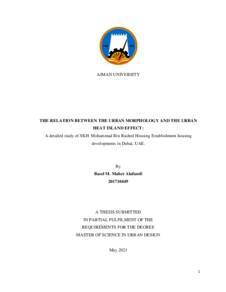وثيقة
download count
4.00
The effect of urban form on the heat island phenomena
العنوان البديل
A comparative study between old and new residential settlements temperature variations in the UAE.
الناشر
Ajman University
تاريخ النشر (نص حر)
2020
اللغة
الأنجليزية
مدى
144 leaves
الموضوع
الملخص
Abstract:
The urban heat island phenomena is considered to be one of the most crucial issues associated with the rapid growth and the urbanization process. The purpose of this research is to examine and evaluate the impact of the different urban configurations and
the urban densities on the temperature variations and the human thermal comfort in the hot-dry climate cities during the year, especially in the summer season. Three old traditional urban configurations were selected based on their various density ratios, while on the other hand, three new structured urban forms were chosen with different density ratios. The six selected urban configurations represent residential settlements in the UAE.
Computer simulations were run by Envi-met software to simulate the six different urban configurations which are: Al Marija, Sidroh, Al Fahidi areas represent the traditional urban form while Al Mamzar, Jumeirah and Al Safa I areas represent the modern urban
form in order to investigate the impact of the different independent variables in each configuration on the UHI through the three seasons (August, December, and April).
There were four different parameters to evaluate the selected urban forms as the building form, street geometry, orientation, and urban density.
The results revealed that the low-density traditional urban form had recorded the lowest air temperature in August as it has low SVF and high H/W ratio and less density. On the other hand, the highest air temperature was recorded by Jumeirah configuration, which
represents the low-medium density, but it has the lowest H/W ratio and the maximum SVF.
The high-density new urban form has recorded lower air temperature than the low and low-medium density new urban form due to the building form, high H/W, low SVF, and wind corridors in the summer season.
In addition to that, the traditional compact urban form (Al Fahidi) with the highest urban density in the six configurations, achieved the optimum thermal comfort levels in the summer season.
المجموعة
مواد أخرى لنفس الموضوع
